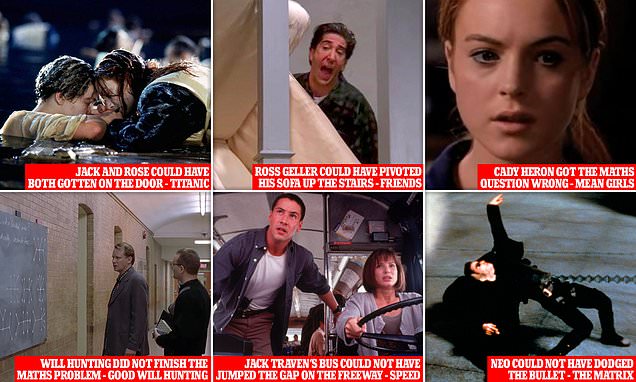In the world of the popular TV series, The Simpsons, Homer Simpson may have predicted the mass of the Higgs boson particle fourteen years before physicists discovered it at CERN. An equation scribbled on a blackboard in a 1998 episode of the show correctly predicted the mass of the Higgs boson, according to physicist Dr. Simon Singh. The Higgs boson, also known as the “God particle,” was first predicted by Peter Higgs and five other physicists in 1964, and its existence was confirmed by scientists working on the Large Hadron Collider in 2013. In the world of movies, ZME Science decided to explore whether the bus jump in the 1994 action movie Speed was plausible. The calculations suggest that the bus would not have made the jump and would have fallen through the gap before exploding. Finally, a video reveals that movie villains are designed with sharp, angular faces to create an impression of being evil, while lovable characters have round features.
Mathematicians Disprove Iconic Film and TV Scenes
Mathematics is not something that most people think about when watching their favorite movies or TV shows. However, some viewers cannot help but be bothered by certain scenes, such as when Keanu Reeves dodges a bullet in The Matrix or when Kate Winslet and Leonardo DiCaprio struggle to stay afloat in Titanic.
Mathematicians have gone so far as to do the calculations and prove that certain scenes in popular films and shows are unrealistic. MailOnline has compiled a list of seven times when mathematicians have debunked iconic moments in cinema and TV history.
Jack and Rose Could Have Both Fit on the Door in Titanic
After the Titanic sinks, Jack and Rose try to climb onto a floating door in the freezing North Atlantic Sea. There is only enough room for one of them on the door, and Jack sacrifices his spot for Rose. However, a group of schoolgirls from Adelaide, Australia, claim they have proven that Jack and Rose could have both survived if they had put their life jackets underneath the door to float to safety.
Ross Geller Did Not Need to Cut Up His Sofa, and Homer Simpson Was a Genius
In Friends, Ross Geller attempts to get his sofa up the stairs, but he is unable to fit it through the narrow hallway. He eventually resorts to sawing the sofa in half. However, a mathematician found that Ross could have gotten the sofa upstairs without cutting it in half if he had only taken measurements.
In an episode of The Simpsons, Homer Simpson discovers the mass of the Higgs Boson, proving that he is not as dim-witted as he lets on.
Other Debunked Scenes
Mathematicians have also debunked several other iconic scenes in cinema and TV history. For example, Cady Heron correctly answers a math question at the Mathletes Championship finals in Mean Girls, and Will Hunting finishes the final math problem in Good Will Hunting.
In Speed, Jack Traven’s bus jumps over a gap in the freeway, but this scene was proven to be unrealistic by mathematicians. Finally, in The Matrix, Neo’s bullet dodge was also deemed unrealistic by mathematicians.
In conclusion, mathematics can play a significant role in analyzing the realism of iconic moments in film and TV history. While some viewers may not care about the accuracy of these scenes, others find it fascinating to see if their favorite moments hold up under closer scrutiny.
How Math Solves Iconic Film Scenes
Mathematics plays a crucial role in assessing the accuracy of iconic scenes in movies and TV shows. Sometimes, scenes are unrealistic, and math can help determine if these scenes hold up under scrutiny.
Could Jack Have Survived in Titanic?
One such iconic scene is the ending of the movie Titanic. After the ship sinks, Jack and Rose struggle to survive in the freezing North Atlantic Sea. They attempt to climb onto a floating door, but there is only room for one of them. Jack sacrifices his spot for Rose, but could he have survived if both of them had gotten onto the door?
A group of schoolgirls from Adelaide, Australia, explored this question by doing the calculations to determine if Jack and Rose could have both survived if they had put their life jackets underneath the door to float to safety. The girls also had to factor in the buoyancy of the door and the effects of the freezing water on the human body.
Experiments to Determine Jack’s Fate
To celebrate the 25th anniversary of the film, director James Cameron also performed experiments to determine Jack’s fate. Two stunt people, dressed in the clothing worn by Kate Winslet and Leonardo DiCaprio in the film, were submerged in a swimming pool. Scientists then went through different scenarios to see if they could both survive.
They found that if both Jack and Rose had tried to get on the door, significant parts of their bodies would have remained in the hypothermic water, causing them to die. However, if Rose had handed Jack her life jacket, it might have stabilized him to the point where he could have survived until a lifeboat arrived.
Ross Geller’s Sofa
Another iconic scene, this time from the TV show Friends, involves Ross Geller attempting to move a sofa up flights of stairs in a New York apartment. Ross, Rachel, and Chandler were unable to manoeuvre the couch around the stairwell, which forced them to cut it into pieces.
However, a mathematician found that the endeavor would have been successful if they had only taken measurements. Data Science Consultant Caroline Zunckel ran simulations based on different measurements of the stairwell and couch and found that the sofa only needed to be tilted upwards to move around the corner.
The Role of Math in Film and TV
The use of math in analyzing iconic scenes in film and TV shows highlights the importance of attention to detail. Viewers can appreciate a movie or TV show more when they know that the creators took the time to ensure that the scenes are realistic.
In conclusion, math can be a useful tool in analyzing the accuracy of iconic scenes in movies and TV shows. The examples discussed above demonstrate how math can help debunk unrealistic scenes and add to our appreciation of these beloved classics.
Famous Movie Scenes Solved by Math
Mathematics has played an important role in the entertainment industry, providing insights and explanations for some of the most iconic scenes in movies and TV shows. In this article, we discuss some of these scenes, how math helped solve them, and what insights we can gain from these solutions.
Ross Geller’s Sofa
In the hit TV show Friends, there is an episode where Ross, Rachel, and Chandler try to move a sofa up flights of stairs in a New York apartment. The trio was unable to maneuver the couch around the stairwell, forcing them to cut it apart.
However, Data Science Consultant Caroline Zunckel ran simulations based on different measurements of the stairwell and couch and found that the sofa only needed to be tilted upwards to move around the corner. By applying Pythagoras’ theorem to the estimated measurements of Ross’s sofa in a vertical position and dimensions of the stairs, she was able to establish that it would have been possible to get the item upstairs. Zunckel provided a mathematical equation that breaks down the measurements and the angle of vertical tilt required to move the couch.
Mean Girls’ Math Question
In the 2003 comedy Mean Girls, Lindsay Lohan’s character Cady competes at the Mathletes Championship finals. She is tasked with answering the last question, which would determine whether her team, from North Shore High, or the opponents takes the crown. The quiz master asks her and Caroline Krafft from the other school to find the limit of an equation he shows on screen. Caroline answers -1 but is told she is incorrect, and then Cady thinks about her answer. She mumbles ‘if the limit never approaches anything, the limit does not exist’ under her breath, before exclaiming ‘the limit does not exist!’.
However, Ray Douse, director at Maths-Whizz, a virtual maths tutoring service, says that this is not actually correct because neither was the question. He explained that the film was technically wrong to ask what the limit of the equation was because it wasn’t an equation on the screen, it was an expression.
Titanic’s Door
Another iconic scene that has puzzled viewers is the ending of the movie Titanic. After the ship sinks, Jack and Rose struggle to survive in the freezing North Atlantic Sea. They attempt to climb onto a floating door, but there is only room for one of them. Jack sacrifices his spot for Rose, but could he have survived if both of them had gotten onto the door?
A group of schoolgirls from Adelaide, Australia explored this question by doing the calculations to determine if Jack and Rose could have both survived if they had put their life jackets underneath the door to float to safety. They also had to factor in the buoyancy of the door and the effects of the freezing water on the human body. Director James Cameron also performed experiments to determine Jack’s fate, which showed that if both Jack and Rose had tried to get on the door, significant parts of their bodies would have remained in the hypothermic water, causing them to die. However, if Rose had handed Jack her life jacket, it might have stabilized him to the point where he could have survived until a lifeboat arrived.
Conclusion
In conclusion, mathematics has played a crucial role in the entertainment industry, helping to solve some of the most iconic scenes in movies and TV shows. These solutions not only provide interesting insights but also help viewers to appreciate these classics better. From the Friends sofa scene to Mean Girls’ math question and Titanic’s door, these examples show the importance of attention to detail and accuracy in storytelling.
Homer Simpson, the lovable but bumbling safety officer at Springfield nuclear power plant, once attempted to disprove a mathematical theorem, and according to physicist and author Dr. Simon Singh, he may have actually succeeded.
The theorem in question is known as Fermat’s Last Theorem, which states that the equation xn + yn = zn has no whole number solutions when n is greater than 2. Singh said that Homer tried to disprove this theorem in a 1998 episode of The Simpsons called “The Wizard of Evergreen Terrace.”
In the episode, Homer, inspired by Thomas Edison, becomes an inventor and creates a machine that is supposed to help him come up with a brilliant invention. However, after a few failed attempts, he uses the machine to write out an equation on the blackboard: 1782^12 + 1841^12 = 1922^12.
Singh, who wrote a book about Fermat’s Last Theorem, said that this equation, although incorrect, is “surprisingly close” to being a solution for the theorem. In fact, if you round off the numbers, the equation is only off by about 0.1%.
Although it’s unlikely that Homer Simpson, a fictional character, was able to solve a centuries-old mathematical problem, the fact that he was able to come up with an equation that was so close to a solution is a testament to the widespread appeal of mathematics and its ability to inspire people in unexpected ways.
Homer Simpson is known for being the hapless, doughnut-obsessed safety officer at Springfield nuclear power plant, but he may have done more than that. In a 1998 episode of The Simpsons called ‘The Wizard of Evergreen Terrace’, Homer becomes an inventor in an attempt to follow in the footsteps of Thomas Edison. Physicist Dr Simon Singh discovered that the formula written on Homer’s blackboard predicts the mass of the Higgs boson, which was first predicted by Professor Peter Higgs and five other physicists in 1964. The Higgs boson is required to explain why other fundamental particles in the universe have mass. The theory states that all subatomic particles interact within an energy field known as the Higgs field, giving them mass.
In the episode, Homer tries to come up with a series of madcap inventions, including an electric hammer and make-up gun. Dr Singh claims that the equation written by Homer on a blackboard is a playful combination of various fundamental parameters, namely the Planck constant, the gravitational constant, and the speed of light. If these numbers are looked up and plugged into the equation, it predicts a mass of 775 giga-electron-volts (GeV), which is close to the 125 GeV estimate that emerged when the Higgs boson was discovered in 2012.
According to Dr Singh, the equation predicts the mass of the Higgs boson. He stated that if the equation is worked out, the mass of a Higgs boson that’s only slightly larger than the actual mass of the Higgs boson is obtained. It’s kind of amazing as Homer makes this prediction 14 years before it was discovered.
The Higgs boson, also known as the God Particle, was discovered by scientists working on the Large Hadron Collider in March 2013. The experiment cost £8.6 billion ($13.25 billion), and they were able to prove the existence of a new particle with a mass of 125Gev/c2.
Could Homer Simpson have predicted the mass of the Higgs boson?
A theoretical physicist at the University of Edinburgh and his colleagues predicted the existence of the Higgs boson in 1964. It took almost five decades, but in March 2013, the particle was discovered by scientists working on the Large Hadron Collider (LHC) at CERN. However, in 1998, Homer Simpson might have predicted the mass of the Higgs boson, according to physicist Dr. Simon Singh.
In “The Wizard of Evergreen Terrace” episode of The Simpsons, Homer becomes an inventor and writes an equation on the blackboard, which Dr. Singh claims predicts the mass of the Higgs boson. By plugging in the values for the Planck constant, the gravitational constant, and the speed of light into the equation, it predicts a mass of 775 giga-electron-volts (GeV), which is not too far off from the 125 GeV estimate that emerged when the Higgs boson was discovered in 2012. The episode aired 14 years before the Higgs boson was discovered, making it an impressive guess.
Could the bus in Speed really make that jump?
The action-packed thriller Speed, released in 1994, featured Keanu Reeves’ character, Officer Jack Traven, trying to keep a bomb-rigged bus driving over 50mph (80 kph) on a freeway. In one scene, the bus meets an incomplete section of the road, and Jack knows that the only way to save himself and the passengers is to accelerate over the gap.
According to calculations by ZME Science, the gap that the bus had to jump was around 50 feet in length (15 m), while the speedometer indicated a speed of about 67 mph (108 kph). However, as the bus was mid-air for just 50 seconds, the mathematicians determined that it would have descended by about 4.3 feet (1.3 m) in reality. This means it would have likely fallen through the gap before it reached the other side and exploded.
Quick reactions and bendy knees in The Matrix
The Matrix tests the limits of physics in various ways throughout the film, including the iconic scene that involves quick reactions and some very bendy knees. In the scene, Neo (Keanu Reeves) dodges bullets while in slow motion, showcasing the power of the mind over the physical world. The Wachowskis used innovative filming techniques, such as bullet time, to create this memorable scene.
In conclusion, these iconic movie scenes test the boundaries of physics in their unique ways. While the physics behind the bus jump in Speed may be questionable, and the physics-defying scenes in The Matrix may be pure fantasy, the equation written on Homer Simpson’s blackboard may have predicted the mass of the Higgs boson 14 years before physicists discovered it.
In the famous rooftop scene in The Matrix, Keanu Reeves’ character, Neo, dodges a bullet by bending completely backwards. The scene is slow-mo, emphasizing Neo’s lightning-fast reaction time. But could this move be possible in real life? Mathematician Kerry Cue has estimated that Neo and the agent were 39 feet (12 m) apart, and the weapon used was a Smith & Wesson .40 M&P, with a muzzle speed of 1,000 feet per second (305 m/s). Given the average human reaction time of 0.25 seconds, it would be impossible to dodge the bullet without the aid of the Matrix.
In another interesting piece of film analysis, a video has revealed that Disney and other filmmakers use geometry to manipulate our emotions towards characters. Villains tend to have sharp, angular features made from triangles, while lovable characters such as Baloo from ‘The Jungle Book’ are made entirely of circles. The mathematical theory behind this is that angular shapes stimulate our subconscious feelings of threat, while circular shapes produce feelings of safety and comfort. By manipulating these shapes, filmmakers can make us empathize with the hero and hate the villain in movies.
Don’t miss interesting posts on Famousbio










